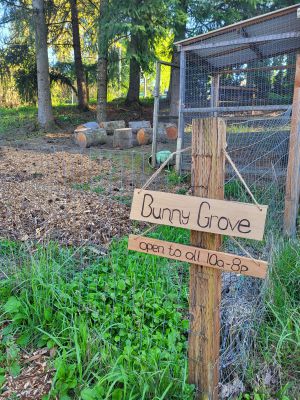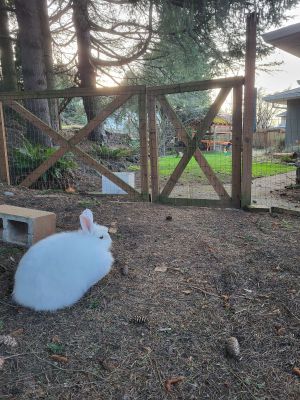Bunny Grove

To begin to model how to open up land toward communal use, we have decided to allow passersby to come into our little Bunny Grove and visit our many trees. With a small picnic circle of logs, a burgeoning garden, and a rambunctious rabbit, we hope to bring joy and peacefulness to anyone who stops by.
The Bunny Grove is off Terwilliger Blvd. in SW Portland (Northern Willamette Valley). The outdoor grove is open to foot traffic (no dogs, please) from 10 a.m. to 8 p.m. We ask that you keep the labeled gates closed so our neighbors do not worry about our rabbit's well-being if she is wandering the neighborhood alone. If you have questions or would like to contact Bunny Grove, please email AVLTAVIN -at- gmail.com.
History
At the end of 2020, Andra and Emily adopted Hermes and Iphigenia (Genie for short), two white Satin-German Angora rabbits. What started as a small habitat in one corner of a large garage quickly grew into a shed converted into a temperature-controlled barn complete with a large bunny run.
While Hermes passed away in 2023 of a respiratory infection, Genie remains happy and healthy, playing with the local neighborhood wildlife.
Interactions with the Rabbit
Genie is very friendly and will likely come right up to you if she hears your voice or thinks you are in the grove. You are welcome to feed her carrot tops or other greens. We recommend making an offering with an open palm and letting her decide if she wants it. For a list of other food you can feed her, please see the "what do the bunnies eat?" section below.
Wildlife in Bunny Grove
We have a small collection of Douglas firs and deodar cedars. We also have Italian plum trees, a cherry tree, a peach tree, a blueberry bush, and raspberry bushes. You are welcome to pick any fruit you find in the grove for yourself or for Genie (she eats a lot of it off the ground anyway). We also have some wild roses (Genie loves to eat those, too), an herb garden, and a Japanese maple.
We hope to propagate and grow more native berries over time.
You might see squirrels or mice in the yard, and there are many birds who spend time in the area. Once, the grove was home to a Polyphemus moth.
Frequently Asked Questions
When do the bunnies go outside?
Rabbits are crepuscular, which simply means they prefer being active at dawn and dusk. So, the best time to see them outside is between 6-9 a.m. and after 5:30 p.m. However, rabbits are also heat sensitive, so during the hottest months, they may be in the garage for several days at a time.
If you don’t see Genie in the barn or the bunny run, she may be in the backyard nibbling on grasses and herbs. We have been letting her out in that pasture more often.
What do the bunnies eat?

We give them Timothy hay, Oxbow pellets, romaine lettuce, and carrot tops from the PSU farmer’s market on the regular. They also like to eat most grasses, herbs, and other leafy greens. Rabbits have a sensitive digestive system, so they can’t have much sugar, but we occasionally give them treats such as carrots, dried pineapple, cherries and plums from our fruit trees, and dried apricots.
You are welcome to feed the bunnies mint and lettuce from our yard if you would like.
How did you convert the shed to be bunny friendly?
The shed came with the property and was full of spiderwebs, sitting unused for several years. We laid new flooring, finished the loft roof, added 100 percent wool insulation, ran some electricity to the shed, added shelves for the bunnies to climb on (they love to climb and jump), and added some carpet squares to be soft on their little feet.
Do you shear your rabbits?
Yes, Andra originally wanted rabbits so that they could spin their fur into yarn. They have since become loved and invaluable members of the family and the community. Some angora rabbits can be plucked, meaning that their fur sheds naturally and can be harvested by gently tugging on the fur during the warm seasons. Some angoras need to be sheared in that they were bred not to shed. Our rabbits are a hybrid breed such that we need to brush AND shear.
During shearing, we make sure that each rabbit has an emotional support person (Emily) as well as a shearer (Andra). We also make them a big treat tray to thank them for all their hard work in grooming and keeping their fur tidy.
While the bunnies don’t love the process of being sheared, they love to jump and play and run without the weight of it on them afterward, and it helps to keep them cool in the hot months. Angora rabbits typically need to be shorn every three to four months.
For more information about the yarn that Andra makes, click here!
Aren’t you worried about predators?
Because the barn is well protected and we took pains to help the bunnies adapt to their space a little bit at a time, we trust their natural instincts and their ability to escape to the barn if they need to. While we know we are taking some risks in that large birds could still access the bunnies, we feel the trade-off is worth it in that they get to have a full and fulfilled life in a natural habitat.
We also give them flea/tick medication regularly to protect them from parasites.
Will you get another rabbit to keep Genie company?
Rabbits are surprisingly territorial and can be quite aggressive if they feel threatened by another rabbit, to the point of injury and/or death. So, it is very, very tricky to bond rabbits—it takes a lot of careful attention and time. Additionally, because rabbits are considered “exotic pets,” the cost to spay/neuter them is more than we can currently afford. However, if we were to find the right rescue, we would consider adopting another rabbit.
